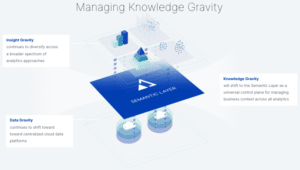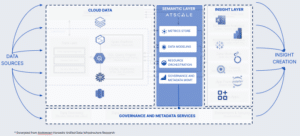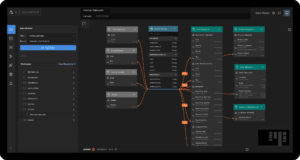March 6, 2019
TECH TALK: AtScale 6.0 brings Universal Semantic Layer Benefits to Google Cloud
In the rapidly evolving landscape of data management and business intelligence (BI), the concept of “knowledge gravity” is reshaping how enterprises and their technology partners leverage data to derive insights and drive business decisions. Knowledge gravity refers to the increasing centralization of data and business logic within accessible, cloud-based platforms, making data more actionable and insightful across various business functions. Let’s dive into the implications of knowledge gravity, its role in successful semantic layer implementations like AtScale, and the opportunities it presents for enterprises, service partners, and technology providers.
The Phenomenon of Knowledge Gravity
Over the past decade, organizations have modernized their data and analytics stacks, with BI insights standardizing on platforms like Power BI, Tableau, Looker, and Excel. This evolution has forced companies to define their business logic directly within these applications, making data more localized around the insights layer. It often materializes as extracts, caches, cubes, views, data marts, and imports tailored for specific business tools and use cases. This approach, however, has led to significant challenges, including inconsistent reporting and a lack of trust in key performance indicators (KPIs) due to ungoverned data definitions.
Shifting Paradigms in Data and Semantic Management

The shift to cloud technologies like Databricks, Snowflake, and Google Cloud’s BigQuery signifies a significant pivot from on-premise solutions to more dynamic, scalable cloud environments. As data consolidates in these powerful elastic platforms, they naturally pull in additional workloads and data from other sources, simplifying data management and enabling real-time analytics without redundant data movements.
This consolidation has set the stage for a new gravitational shift in companies’ business logic and semantic definitions, encompassing critical measures and dimensions such as revenue, sales, orders, time, and product type. Previously, these definitions were either embedded in the data layer or defined at the insights layer, complicating the delivery of business-critical KPIs and reconciliation across functions.
Implementing a Successful Semantic Layer
A universal semantic layer like AtScale addresses these challenges by providing a consistent governance framework that allows all organizational stakeholders to define and manage business data definitions coherently. By harnessing the elastic computing power of cloud platforms, companies can eliminate traditional data silos like data marts and imports, enabling direct, live access to business data through modern BI, embedded analytics, and AI-driven applications.
Semantic models should be accessible via a live connection, supporting various protocols, including SQL for BI applications, REST, DAX, and MDX for custom analytics, and Python for Generative AI and machine learning integrations. This setup not only streamlines data access but also enhances the reliability and governance of enterprise analytics.

For a semantic layer platform to be effective, it has to do it all. At the 2024 Semantic Layer Summit, we announced our most significant semantic layer technology stack innovations, which empower business teams, analytics engineers, and data scientists to create analytics products collaboratively. To learn more about our latest innovation, read our product innovations recap.
Opportunities for Service Partners and Technological Advancements
Service partners play a crucial role in the gravitational pull of enterprise knowledge to a universal semantic layer. They are at the forefront of taking their domain expertise and defining semantic models that cater to the specific needs of their enterprise customers. The evolution of AtScale’s Partner Program aims to deepen the involvement and collaboration among partners, empowering them to leverage their expertise to help enterprises achieve their business goals.

As data continues to be centralized in cloud platforms, the ability to manage and utilize this data effectively through a well-implemented semantic layer will dictate the future of business intelligence and data analytics.
Watch my keynote on demand from the Semantic Layer Summit to learn more about the evolution of knowledge gravity and the AtScale Semantic Layer.
ANALYST REPORT